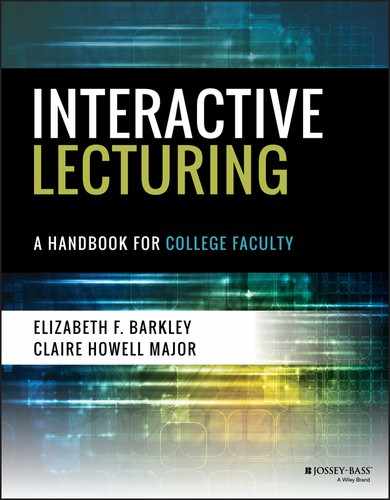ENGAGING LECTURE TIP 40
Every Minute Matters
Like it not, in higher education, we still measure courses in terms of time. We teach courses that are worth a certain number of credit hours each academic term. We teach courses that meet for one or more sessions each week. We teach for a certain number of minutes or hours each class session. Even for those of us who teach online, there is often an expectation that the course should take the equivalent amount of time that it would take if it were being held face-to-face. In Every Minute Matters, we propose that professors use the full amount of class time to the best possible end. Whether it's starting a session, transitioning between lecture and a hands-on activity, or ending a session, you can always be teaching, and students can always be learning.
When you think of “every minute,” it is important to recognize the range of activities that go on at the beginning, middle, and end of a class session. Consider the following.
Starting Class
Informal chats with students about topics unrelated to the learning goals for a particular session are an important part of creating a positive class climate and of getting to know students. They will make students feel more comfortable and welcomed. We suggest showing up to class a few minutes early to have those conversations. When you and students chat before class, it frees you to begin class on time and to use every minute at your disposal for ensuring that students meet their learning goals.
Lecturing and Facilitating Learning
Lecturing for a full-class session is not efficient time use because students cannot maintain attention for that long. Instead, consider developing a solid class plan that combines lectures and student activities so that you have engaged students for the maximum amount of time. Working within the limits of human attention and providing opportunities to reset attention is the best way to make Every Minute Matters.
Ending Class
It is sometimes tempting to end a class session a few minutes early. When we come to a natural breaking point in the content with just a few minutes left on the clock, it can feel almost natural to say, “Well, we're almost out of time” or “We don't have enough time to start something new” or simply “Let's call it good for today.” Although a single occurrence of this may amount only to four or five minutes, this time becomes significant if it becomes a regular pattern, and we end up shortchanging learning. In the following table, you can see what happens if you end class five minutes early each session.
| Class Length | Sessions per Week | Lost Time over a Sixteen-Week Semester | Hours of Lost Class Sessions |
| 50 minutes | 3 times | 240 minutes/4 hours | 4.8 |
| 75 minutes | 2 times | 160 minutes/2.7 hours | 2.1 |
When you are clear on your goals and have done careful planning, you can ensure that you maximize learning by taking advantage of the important time you have with students. For ideas of what to do with an additional five minutes, see Tip 41: Extensions.
Example
Key Reference and Resource
- Lemov, D. (2010). Teach like a champion: 49 strategies that put students on the path to success. San Francisco, CA: Jossey-Bass.
